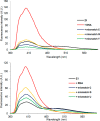C5-alkynyl-functionalized α-L-LNA: synthesis, thermal denaturation experiments and enzymatic stability
- PMID: 24797769
- PMCID: PMC4049248
- DOI: 10.1021/jo5006153
C5-alkynyl-functionalized α-L-LNA: synthesis, thermal denaturation experiments and enzymatic stability
Abstract
Major efforts are currently being devoted to improving the binding affinity, target specificity, and enzymatic stability of oligonucleotides used for nucleic acid targeting applications in molecular biology, biotechnology, and medicinal chemistry. One of the most popular strategies toward this end has been to introduce additional modifications to the sugar ring of affinity-inducing conformationally restricted nucleotide building blocks such as locked nucleic acid (LNA). In the preceding article in this issue, we introduced a different strategy toward this end, i.e., C5-functionalization of LNA uridines. In the present article, we extend this strategy to α-L-LNA: i.e., one of the most interesting diastereomers of LNA. α-L-LNA uridine monomers that are conjugated to small C5-alkynyl substituents induce significant improvements in target affinity, binding specificity, and enzymatic stability relative to conventional α-L-LNA. The results from the back-to-back articles therefore suggest that C5-functionalization of pyrimidines is a general and synthetically straightforward approach to modulate biophysical properties of oligonucleotides modified with LNA or other conformationally restricted monomers.
Figures





Similar articles
-
Synthesis and biophysical properties of C5-functionalized LNA (locked nucleic acid).J Org Chem. 2014 Jun 6;79(11):5047-61. doi: 10.1021/jo500614a. Epub 2014 May 13. J Org Chem. 2014. PMID: 24825249 Free PMC article.
-
Synthesis, hybridization characteristics, and fluorescence properties of oligonucleotides modified with nucleobase-functionalized locked nucleic acid adenosine and cytidine monomers.J Org Chem. 2014 Jul 3;79(13):6256-68. doi: 10.1021/jo500994c. Epub 2014 Jun 24. J Org Chem. 2014. PMID: 24933409
-
Carbohydrate-functionalized locked nucleic acids: oligonucleotides with extraordinary binding affinity, target specificity, and enzymatic stability.Org Lett. 2014 Jun 20;16(12):3308-11. doi: 10.1021/ol501306u. Epub 2014 Jun 3. Org Lett. 2014. PMID: 24890872
-
Locked vs. unlocked nucleic acids (LNA vs. UNA): contrasting structures work towards common therapeutic goals.Chem Soc Rev. 2011 Dec;40(12):5680-9. doi: 10.1039/c1cs15048k. Epub 2011 May 10. Chem Soc Rev. 2011. PMID: 21556437 Review.
-
Promising nucleic acid analogs and mimics: characteristic features and applications of PNA, LNA, and morpholino.Appl Microbiol Biotechnol. 2006 Aug;71(5):575-86. doi: 10.1007/s00253-006-0434-2. Epub 2006 May 9. Appl Microbiol Biotechnol. 2006. PMID: 16683135 Review.
Cited by
-
Synthesis and biophysical properties of C5-functionalized LNA (locked nucleic acid).J Org Chem. 2014 Jun 6;79(11):5047-61. doi: 10.1021/jo500614a. Epub 2014 May 13. J Org Chem. 2014. PMID: 24825249 Free PMC article.
-
Conjugation and Evaluation of Small Hydrophobic Molecules to Triazole-Linked siRNAs.ACS Med Chem Lett. 2014 Dec 4;6(2):117-22. doi: 10.1021/ml500260j. eCollection 2015 Feb 12. ACS Med Chem Lett. 2014. PMID: 25699137 Free PMC article.
-
Recent Advances in Nucleic Acid Targeting Probes and Supramolecular Constructs Based on Pyrene-Modified Oligonucleotides.Molecules. 2017 Nov 30;22(12):2108. doi: 10.3390/molecules22122108. Molecules. 2017. PMID: 29189716 Free PMC article. Review.
References
-
-
For recent reviews on conformationally restricted nucleotides, see e.g.:
- Herdewijn P. Chem. Biodiv. 2010, 7, 1–59. - PubMed
- Obika S.; Abdur Rahman S. M.; Fujisaka A.; Kawada Y.; Baba T.; Imanishi T. Heterocycles 2010, 81, 1347–1392.
- Prakash T. P. Chem. Biodiv. 2011, 8, 1616–1641. - PubMed
- Zhou C.; Chattopadhyaya J. Chem. Rev. 2012, 112, 3808–3832. - PubMed
-
-
-
For particularly important early examples, please see:
- Eschenmoser A. Science 1999, 284, 2118–2124. - PubMed
- Hendrix C.; Rosemeyer H.; Verheggen I.; Van Aerschot A.; Seela F.; Herdewijn P. Chem. Eur. J. 1997, 3, 110–120.
- Wang J.; Verbeure B.; Luyten I.; Lescrinier E.; Froeyen M.; Hendrix C.; Rosemeyer H.; Seela F.; Van Aerschot A.; Herdewijn P. J. Am. Chem. Soc. 2000, 122, 8595–8602.
- Bolli M.; Trafelet H. U.; Leumann C. Nucleic Acids Res. 1996, 24, 4660–4667. - PMC - PubMed
- Renneberg D.; Leumann C. J. J. Am. Chem. Soc. 2002, 124, 5993–6002. - PubMed
-
-
-
For representative recent examples, see:
- Seth P. P.; Vasquez G.; Allerson C. A.; Berdeja A.; Gaus H.; Kinberger G. A.; Prakash T. P.; Migawa M. T.; Bhat B.; Swayze E. E. J. Org. Chem. 2010, 75, 1569–1581. - PubMed
- Liu Y.; Xu J.; Karimiahmadabadi M.; Zhou C.; Chattopadhyaya J. J. Org. Chem. 2010, 75, 7112–7128. - PubMed
- Upadhayaya R.; Deshpande S. A.; Li Q.; Kardile R. A.; Sayyed A. Y.; Kshirsagar E. K.; Salunke R. V.; Dixit S. S.; Zhou C.; Foldesi A.; Chattopadhyaya J. J. Org. Chem. 2011, 76, 4408–4431. - PubMed
- Madsen A. S.; Wengel J. J. Org. Chem. 2012, 77, 3878–3886. - PubMed
- Haziri A. I.; Leumann C. J. J. Org. Chem. 2012, 77, 5861–5869. - PubMed
- Gerber A.-B.; Leumann C. J. Chem. Eur. J. 2013, 19, 6990–7006. - PubMed
- Hari Y.; Osawa T.; Kotobuki Y.; Yahara A.; Shrestha A. R.; Obika S. Bioorg. Med. Chem. 2013, 21, 4405–4412. - PubMed
- Hari Y.; Morikawa T.; Osawa T.; Obika S. Org. Lett. 2013, 15, 3702–3705. - PubMed
- Migawa M. T.; Prakash T. P.; Vasquez G.; Seth P. P.; Swayze E. E. Org. Lett. 2013, 15, 4316–4319. - PubMed
- Hanessian S.; Schroeder B. R.; Merner B. L.; Chen B.; Swayze E. E.; Seth P. P. J. Org. Chem. 2013, 78, 9051–9063. - PubMed
-
-
- Duca M.; Vekhoff P.; Oussedik K.; Halby L.; Arimondo P. B. Nucleic Acids Res. 2008, 36, 5123–5138. - PMC - PubMed
- Bennett C. F.; Swayze E. E. Annu. Rev. Pharmacol. Toxicol. 2010, 50, 259–293. - PubMed
- Østergaard M. E.; Hrdlicka P. J. Chem. Soc. Rev. 2011, 40, 5771–5788. - PMC - PubMed
- Watts J. K.; Corey D. R. J. Pathol. 2012, 226, 365–379. - PMC - PubMed
- Matsui M.; Corey D. R. Drug Discuss. Today 2012, 17, 443–450. - PMC - PubMed
- Dong H.; Lei J.; Ding L.; Wen Y.; Ju H.; Zhang X. Chem. Rev. 2013, 113, 6207–6233. - PubMed
-
- Singh S. K.; Nielsen P.; Koshkin A. A.; Wengel J. Chem. Commun. 1998, 455–456.
Publication types
MeSH terms
Substances
Grants and funding
LinkOut - more resources
Full Text Sources
Other Literature Sources
Miscellaneous

